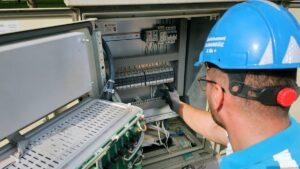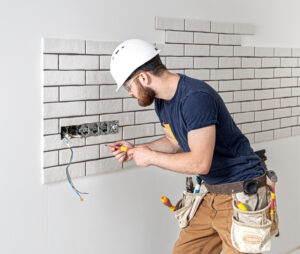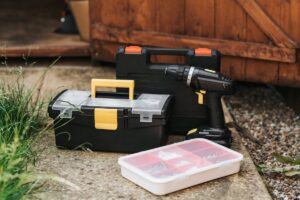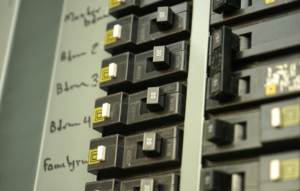In today’s workplaces, where technology is an integral part of daily operations, the use of power strips has become increasingly common. Whether it’s for powering multiple computers in an office, keeping machinery running in a workshop, or ensuring that all necessary equipment in a retail space is operational, power strips are indispensable. However, with their convenience comes a significant risk: improper use of power strips can lead to severe electrical hazards, including fires, shocks, and equipment damage. For businesses in Alabama and Georgia, where regulations and safety standards must be rigorously adhered to, ensuring the safe use of power strips is crucial.
This guide provides a comprehensive overview of best practices for power strip safety in the workplace, helping to prevent electrical hazards and ensuring a safe environment for all employees.
-
Understanding the Dangers of Power Strips in the Workplace
Power strips are not designed to handle high electrical loads for extended periods. When misused, they can become a significant fire hazard. According to the U.S. Fire Administration, electrical malfunctions, including those caused by overloaded power strips, account for a considerable number of workplace fires each year.
Why Workplaces Are More Vulnerable
Workplaces often have a higher demand for electricity due to the number of devices and equipment in use simultaneously. This demand can quickly overwhelm standard power strips, especially if they are not rated for the necessary load. Additionally, in environments like workshops or factories, where heavy machinery is used, the risk of overloading power strips is even greater.
Statistics on Workplace Electrical Fires
In the U.S., electrical fires in non-residential buildings, including workplaces, account for about 8,200 fires annually. Many of these fires are preventable with proper electrical safety practices, including the correct use of power strips. In Alabama and Georgia, where industries such as manufacturing, healthcare, and retail are prominent, adhering to these safety practices is particularly important.
-
Best Practices for Power Strip Safety in the Workplace
To prevent electrical hazards, it is essential to follow best practices when using power strips in the workplace. Here are some key guidelines:
-
Choose the Right Power Strip
Not all power strips are created equal. When selecting a power strip for workplace use, consider the following:
-
Load Capacity:
Ensure that the power strip can handle the total electrical load of the devices you intend to plug into it. The strip should have a higher amp rating than the combined load of all devices.
-
Surge Protection:
Choose a power strip with built-in surge protection. This feature protects your equipment from voltage spikes, which can occur due to power surges, particularly in regions prone to thunderstorms, like Alabama and Georgia.
-
UL Certification:
Always select power strips that are UL (Underwriters Laboratories) certified. This certification ensures that the product meets strict safety standards.
-
Avoid Overloading Power Strips
Overloading a power strip is one of the most common causes of electrical fires. To avoid this:
-
Calculate the Load:
Before plugging devices into a power strip, calculate the total wattage and ensure it does not exceed the strip’s capacity. For example, if a power strip is rated for 1800 watts and you plan to plug in three devices that each use 500 watts, you’ll be well within the safe range. However, adding more high-wattage devices could push the strip beyond its limit.
-
Distribute the Load:
If your workplace requires multiple high-wattage devices, spread them across different circuits or use additional power strips to distribute the electrical load evenly.
-
Proper Placement of Power Strips
Where you place power strips in the workplace is just as important as how you use them. Improper placement can lead to overheating and other hazards.
-
Ventilation:
Ensure that power strips are placed in well-ventilated areas where heat can dissipate. Avoid placing them under rugs, behind curtains, or in other enclosed spaces that can trap heat.
-
Accessibility:
Power strips should be easily accessible for employees to unplug devices in case of an emergency. Do not hide them behind heavy furniture or machinery.
-
Avoid Moisture:
Never place power strips in areas where they could be exposed to moisture, such as near sinks or in outdoor environments. If moisture enters a power strip, it can cause a short circuit and lead to a fire or electrical shock.
-
Regular Inspections and Maintenance
Power strips should be inspected regularly for signs of wear and tear. Damaged power strips are a significant safety hazard and should be replaced immediately.
-
Inspect for Damage:
Look for frayed cords, loose connections, and cracks in the casing. If you notice any damage, replace the power strip immediately.
-
Test the Surge Protector:
If your power strip has surge protection, test it regularly to ensure it is functioning correctly. Some power strips have an indicator light that shows whether the surge protection is active.
-
Schedule Maintenance:
Incorporate power strip inspections into your regular workplace maintenance schedule. This proactive approach can prevent potential hazards before they become serious issues.
-
Educating Employees on Power Strip Safety
Even with the best practices in place, employee education is crucial for maintaining power strip safety in the workplace. Employees should be aware of the risks associated with improper use and be trained on how to use power strips safely.
-
Conduct Safety Training
Regular safety training sessions should include information on the correct use of power strips. Topics to cover include:
-
Identifying Safe Power Strips:
Educate employees on how to identify safe, certified power strips and recognize signs of wear and tear.
-
Proper Usage:
Teach employees how to calculate electrical loads and distribute devices across multiple power strips or circuits.
-
Emergency Procedures:
Ensure that employees know what to do if they suspect a power strip is malfunctioning or if they notice signs of overheating.
-
Implement a Reporting System
Encourage employees to report any damaged power strips or unsafe practices immediately. A simple reporting system can be the difference between a minor issue and a major electrical hazard.
-
Promote a Culture of Safety
Fostering a culture of safety within the workplace is essential. Regularly remind employees about the importance of power strip safety through signage, emails, and team meetings.
-
The Impact of Weather Conditions on Electrical Safety
Weather conditions can have a significant impact on electrical safety, especially in states like Alabama and Georgia, where thunderstorms and high humidity are common.
-
Surge Protection During Storms
Thunderstorms can cause power surges, which may damage electrical equipment connected to power strips. In Alabama and Georgia, where such weather events are frequent, using power strips with surge protection is essential. Consider investing in whole-building surge protectors for additional safety.
-
Humidity and Electrical Equipment
High humidity levels, common in the southern states, can affect electrical equipment. Moisture can accumulate in power strips, leading to potential short circuits. Ensuring that power strips are placed in dry, well-ventilated areas is crucial.
-
Seasonal Changes
Seasonal changes can also impact electrical safety. For instance, during the winter, the increased use of heaters can add strain to power strips. Businesses should adjust their power strip usage accordingly and ensure that all electrical equipment is adequately maintained.
-
Legal and Compliance Considerations
Compliance with electrical safety regulations is not just about avoiding fines; it’s about ensuring the safety of everyone in the workplace.
-
OSHA Guidelines
The Occupational Safety and Health Administration (OSHA) has specific guidelines regarding the use of power strips in the workplace. These include ensuring that power strips are not used as a substitute for permanent wiring and that they are only used with appropriate devices.
-
State-Specific Regulations
Both Alabama and Georgia have state-specific regulations that businesses must adhere to. These regulations often include requirements for electrical inspections, certifications for equipment, and protocols for emergency preparedness. Understanding and complying with these regulations is critical for maintaining a safe workplace.
-
Regular Inspections and Documentation
Maintaining documentation of regular electrical inspections and safety training sessions is vital for compliance. This documentation can be crucial in the event of an inspection or if an incident occurs.
-
Innovations in Power Strip Technology
Advancements in power strip technology are making workplaces safer by offering new features that help prevent common electrical hazards.
-
Smart Power Strips
Smart power strips can detect when devices are not in use and automatically cut power to those outlets, reducing the risk of overloads and saving energy. These strips often come with surge protection and can be controlled remotely, providing an added layer of safety.
-
Weatherproof Power Strips
For outdoor or humid environments, weatherproof power strips are a great option. These strips are designed to withstand exposure to moisture and other environmental factors, making them ideal for workplaces in Alabama and Georgia.
-
Power Strips with Circuit Breakers
Some power strips now come equipped with built-in circuit breakers that automatically shut off power if the strip becomes overloaded. This feature can prevent electrical fires and damage to connected devices.
-
The Role of Professional Electrical Services
-
Installing Additional Outlets
Installing additional outlets can help distribute the electrical load more evenly and reduce the need for daisy-chaining power strips, which can be hazardous.
-
Upgrading Electrical Systems
Older electrical systems may not be able to handle the increased demand for power, leading to frequent overloads and potential hazards. Professional electricians can assess your current system and recommend upgrades or repairs to ensure it meets modern safety standards. This might include updating wiring, adding new circuits, or installing more advanced safety devices.
-
Emergency Repairs and Support
In the event of an electrical malfunction or emergency, having a professional electrical service provider on call can make a significant difference. Prompt repairs and maintenance can prevent minor issues from escalating into major problems. CMS Maintenance Service offers emergency support to address urgent electrical issues and ensure the continued safety of your workplace.
-
FAQs on Power Strip Safety
-
Can Power Strips Be Used Outdoors?
Power strips are generally not designed for outdoor use unless they are specifically labeled as weatherproof. Outdoor environments expose power strips to moisture and extreme temperatures, which can lead to malfunction and safety hazards. For outdoor applications, use power strips that are rated for outdoor use and ensure they are installed in weatherproof enclosures.
-
What Should I Do If a Power Strip Feels Warm to the Touch?
If a power strip feels warm, it may be a sign of an overload or internal fault. Immediately unplug all devices and inspect the strip for any visible damage. If the strip continues to feel warm or if there are signs of burning or melting, replace it immediately and have it checked by a professional electrician.
-
Is It Safe to Plug a Power Strip into Another Power Strip?
Plugging one power strip into another, known as “daisy-chaining,” is not recommended. This practice can overload the power strip and increase the risk of electrical fires. Always plug power strips directly into wall outlets and avoid using extension cords or additional power strips to expand the number of outlets.
-
How Can I Safely Use Power Strips with High-Wattage Equipment?
When using power strips with high-wattage equipment, ensure that the strip is rated to handle the combined wattage of all plugged-in devices. Consider using power strips with higher capacity ratings or distributing devices across multiple outlets or circuits to avoid overloading.
-
How Often Should Power Strips Be Replaced?
Power strips should be replaced if they show any signs of damage, such as frayed cords, cracked casings, or loose connections. Additionally, even if a power strip appears to be in good condition, it’s a good practice to replace it every few years to ensure continued safety and performance.
-
The Importance of Regular Inspections and Maintenance
Regular inspections and maintenance of power strips and the broader electrical system in your workplace are vital for safety and efficiency. Incorporating these practices into your maintenance routine can prevent potential issues and ensure that all electrical equipment is functioning correctly.
-
Scheduled Inspections
Set up a schedule for regular inspections of all power strips and electrical equipment. This could be done quarterly, bi-annually, or annually, depending on the demands of your workplace and the age of your electrical system.
-
Professional Assessment
Engage a professional electrical service provider to conduct comprehensive assessments. They can check for hidden issues, ensure compliance with safety regulations, and provide recommendations for improvements.
-
Employee Training and Awareness
Regularly update your employees on electrical safety practices and the importance of reporting potential hazards. Conduct refresher courses and provide resources to keep safety top-of-mind.
-
Documentation and Record-Keeping
Maintain detailed records of all inspections, maintenance activities, and training sessions. This documentation can be valuable for regulatory compliance and for identifying patterns that may indicate underlying issues.
Implementing Effective Power Strip Safety Measures: Ensuring a Secure and Compliant Workplace
Ensuring power strip safety in the workplace is crucial for preventing electrical hazards and maintaining a safe working environment. By following best practices for power strip use, educating employees, and partnering with professional electrical services, businesses in Alabama and Georgia can significantly reduce the risk of electrical fires, shocks, and other hazards. Regular inspections, proper equipment selection, and adherence to safety guidelines are essential components of a comprehensive electrical safety strategy.
As technology and workplace demands continue to evolve, staying informed about power strip safety and implementing proactive measures will help protect your business, employees, and property. For tailored solutions and expert advice, consider partnering with a professional electrical service provider like CMS Maintenance Service to ensure that your workplace remains safe and compliant with the latest regulations.









